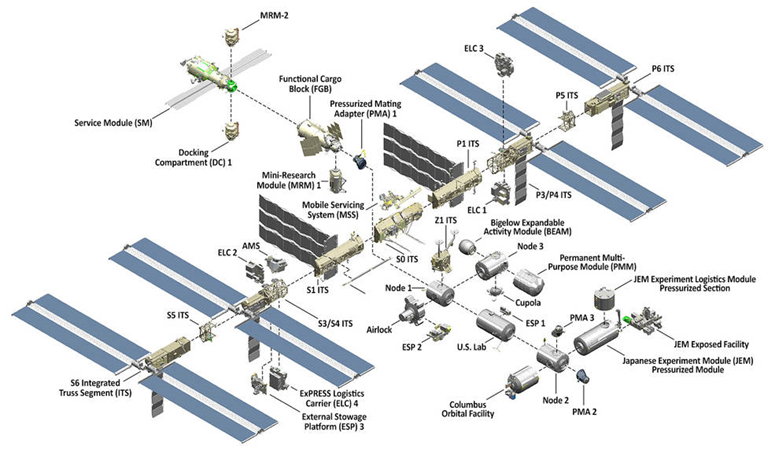The International Space Station...facts and figures

– 240 individuals from 19 different countries visited the International Space Station
-The space station has been in continuous operation since November 2000
The international crew of six people can work and live during the space flight at a speed of five miles per second, orbiting the Earth every 90 minutes.
-In 24 hours, the space station makes 16 orbits from Earth, launching during 16 sunrises and sunsets.
-Peggy Whitson set the record for spending the most total time living and working in space at 665 days on September 2, 2017
The acres of solar panels that power the station mean it's possible to look up at the sky at dawn or dusk and see a spaceship soaring overhead over homes, even if you live in a big city.
-The station's living and working space is larger than a six-bedroom house (six bedrooms, two bathrooms, gym, and 360-degree viewing window).
To mitigate the loss of muscle and bone mass in the human body due to little gravity, astronauts work out at least two hours a day.
Astronauts have conducted 230 spacewalks to build, maintain and modernize the space station since December 1998.
-The solar cell's wingspan (240 feet) is roughly the same length as the world's largest airliner, the Airbus A380.
-The station's large modules and other pieces were delivered aboard 42 assembly flights, 37 on American space shuttles and five on Russian Proton and Soyuz rockets.
-The space station is 357 feet from end to end
Eight miles of wire connect the electrical power system aboard the space station.
The 55-foot Canadarm2 robot has seven different joints and two hands, which in turn moves entire units, deploys scientific experiments, and even transports astronauts for walks.
Eight spaceships can be connected to the space station during one flight.
-The spacecraft can reach the International Space Station four hours after its launch from Earth.
-Introduces four different cargo spacecraft which in turn ship scientific materials, cargo and supplies: Northrop Grumman's Cygnus, SpaceX's DragonX, JAXA's HTV, and Russian Progress.
Through Expedition 58, the Microgravity Laboratory has hosted more than 2,700 papers from scientists in more than 103 countries.
The station's orbital path takes more than 90 percent of the Earth's population, as astronauts take millions of pictures of planet Earth.
-More than 20 different research payloads can be hosted off-station simultaneously, including Earth sensing equipment, materials science payloads, and particle physics experiments such as the Alpha Magnetometer.
-The space station travels a distance equal to the moon and returns in about a day.
-The water recovery system reduces the crew's reliance on water delivered by cargo vehicle by 65 percent – from about 1 gallon per day to one-third of a gallon.
On-orbit monitors approximately 350,000 sensors, ensuring the safety of the station and its crew.
-The internal pressurized volume of the space station is equal to that of a Boeing 747 aircraft.
-More than 50 computers control the space station's systems.
-Supports more than 3 million lines of software code on the ground and more than 1.5 million lines of software code in flight.
In the American segment of the International Space Station alone, more than 1.5 million lines of software code run in flight on 44 computers that communicate over 100 data networks that transmit 400,000 signals (such as pressure or temperature measurements, valve positions, etc.).

Mass and volume of the International Space Station:
-Compact unit length: 167.3 feet (73 meters)
-Gear Length: 357.5 feet (109 meters)
-Solar cell length: 239.4 feet (73 meters)
-Mass: 925,335 lb (419,725 kg)
-Habitable volume: 13,696 cubic feet (388 cubic metres) excluding visiting vehicles
-Compressed volume: 32,333 cubic feet (916 cubic metres)
-With BEAM expansion: up to 32,898 cubic feet (932 cubic metres)
T-Power generation: 8 solar cells provide 75 to 90 kilowatts of energy
-Lines of computer code: about 2.3 million
Source : websites

